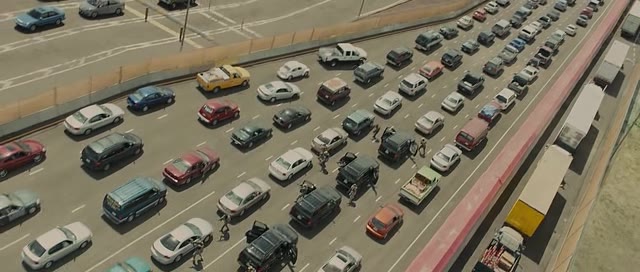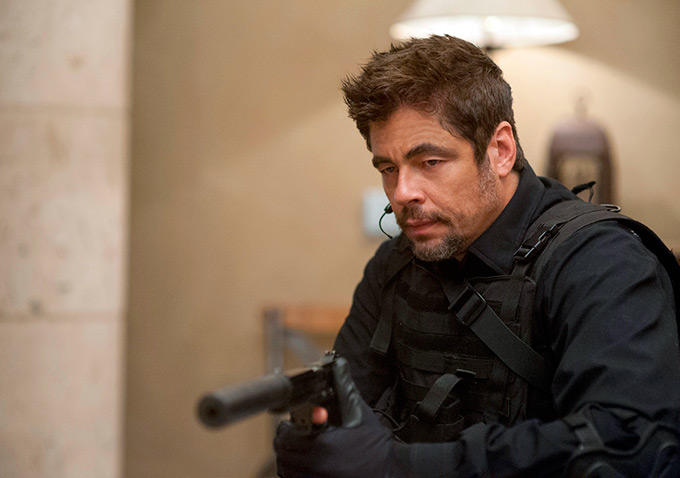
Sicario has one of those rare trailers that absolutely nail the the tone without giving anything in particular away. It communicates the lurking violence and confusion of the drug war by taking pieces from No Country for Old Men and Miss Bala, displaying a film that straddles the U.S.-Mexico border to illustrate people on either side. Unfortunately Sicario tends to resemble Miss Bala more than the Coen epic, often becoming hysterical about the fears and dilemmas presented. Certainly the actions of the cartels and our northern bureaucracy are sometimes despicable, but director Villeneuve lessens the impact by inserting Emily Blunt as a tearful cludge of a moral compass. Sicario works best when Blunt is simply uninvolved and observing, when Villeneuve layers events for the audience to process. For those parts of the film, he’s constructed a fascinating look at a dark whirling machine that seems to have no master or compassion.
Blunt plays a DEA agent in the Southwest U.S. warzone, a grunt kicking in doors in an effort to stymie the drug-related violence creeping over from Mexico. Sicario is talking about a real problem; in 2010 Jaurez Mexico saw 3000 people murdered. The Mexican government more or less went to war with the cartels and now the murder rate has fallen appreciably to 300 people per year. Sicario is not a documentary or didactic however, it is all tone. We don’t learn about the causes leading to this open warfare, and Villeneuve doesn’t seem to be relating his story to the arc of history. Facts and people are kept ambiguous. Agencies and cartels are fluid indefinite enemies, leaving Sicario to dig into the paranoid fear that arises from pure capitalist warfare.
 |
| I feel like America would be more supportive of a War on Traffic |
Villeneuve’s specialty is claustrophobia, an appropriate skill for this allegory film. At almost every moment someone is confined and squeezed. People are trapped in walls, cars, cornered in apartments, and forced through tunnels. Danger often comes from all sides, but you’re always trapped in the cage with it. This effectively heightens the fear of a dissolute but vicious enemy. When conflict comes it is physical. A stunning Benicio del Toro, perfect for this role, pauses a moment to chat on his way to an interrogation, with a giant office cooler style water jug under his arm. Moments later he leers into the holding cell, 95% menace and 5% purpose, the jug thudding heavily on the ground. Villeneuve doesn’t let any romance leak into the action. Gunfights are confusing mazes, and close combat has more in common with beatings. The part of the film that follows del Toro to the denouement is well constructed, a grim reminder of the price of unilateral action without oversight. Villeneuve asks us to concede that if on the route to protecting ourselves from the degradations of addiction we also maim innocent people, perhaps we’re not the good guys we claim to be? The machinations of the agency in Sicario also make the point that the colloquial use of “war” on drugs is oddly accurate, as it is an actual war against foreign nationals for political power, complete with artillery, collateral damage, and suspension of morality in times of crisis.
 |
| I think you could get one of those lights for your Gameboy way back when |
A shame then, that our guide to this is Blunt’s triggerwoman; a powerless cypher for Americans at large. The recruitment discussions around her sell a badass FDA veteran, a no-nonsense career doorkicker. However from the opening moments on Blunt comes across as simply lucky, surviving harrowing encounters by a hair’s breath. There’s no need to give Blunt’s agent Macer super powers, but Villeneuve’s need for her to be vulnerable does not supercede the need for the narrative to be believable. There is simply no adequate replacement for competency in a story like this, which deals with military (police) systems of order. Instead Macer acts hysterical and naive in equal measure, a poor combination when the film sets her up as the moral witness. Her righteous indignation is not worth the sadistic impulses lifted from every other film involving crime and women. This becomes mostly problematic near the end of the film, when the writing starts to give out a little. It has to wrap up on her, but Macer has nothing compelling to give us. None of this is Blunt’s fault, as she does an admirable job with a script that prefers to feel rather than think it’s way through a screwed up situation. However her character is too purposefully frustrating, too much of a footnote that needs a perfunctory signature even in her own movie.
 |
| Service with a very slight smile |
Sicario’s reliance on Blunt’s act of witness for structure is a major flaw, but Villeneuve certainly achieves an effective tone. There’s a singular great scene, a nearly silent descent into a border tunnel during an epic sunset, which both looks amazing and nails the queasy uncertainty of being involved in a quasi-legal lethal raid. The film is also a different viewpoint on the subject, resisting the desire to white knight US citizens ( though no doubt an impulse Villeneuve lacks) and create obvious villains from thugs and rogue agents. It bears a striking resemblance to Zero Dark Thirty’s wandering first majority, though obviously without that film’s factual crown jewel helicopter setpiece. While it misses out on larger aspirations, Sicario is a unique and textured piece of gangland cinema.
Rating : 3/4
Originally published on Synthetic Error February 15, 2016
Comments
Post a Comment